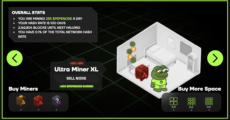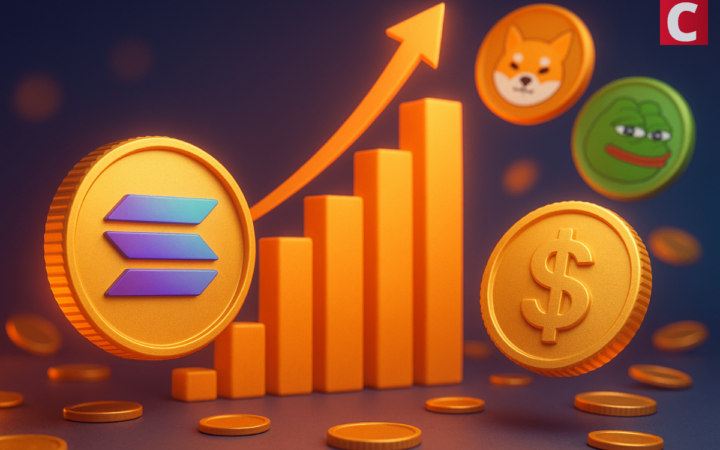
Mining 1 BTC Could Fuel 61 Homes a Year – PepeNode Promotes a Greener Mining Approach as Funding Hits $1.9M

The cost to mine Bitcoin (BTC) today is far beyond what it was a decade ago. Recent data shows that producing just one BTC now consumes enough energy to power 61 homes for an entire year.
New crypto project PepeNode (PEPENODE) isn’t trying to compete with that – it’s offering a cleaner, more efficient alternative. Instead of mining BTC, PepeNode allows users to mine the fastest-growing assets in crypto right now: meme coins.
Through its virtual mining system, players can earn tokens like Pepe (PEPE) and Fartcoin (FARTCOIN), which have delivered returns of over 125x and 17x, respectively, in a fraction of the time it took Bitcoin to achieve comparable results.
Strong presale traction underscores growing market confidence, as PepeNode crosses $1.9 million in funding ahead of its next scheduled price tier. The current round closes in two days, with tokens priced at $0.0011138 before the next scheduled increase.
Rising Energy Costs Have Driven Retail Miners Out of the Bitcoin Game
Research from NFTevening shows that mining a single Bitcoin (BTC) would consume around 6.4 million kilowatt-hours (kWh) of electricity.
Following the 2024 halving, that level of energy use would be enough to power 61 U.S. homes for an entire year or to drive a Tesla Model 3 around the world 86 times.
However, for a single miner, this would be a herculean task. The same research estimates it could take nearly 12 years to mine just one BTC using roughly 44,444 kWh of power each month.
NFTevening also noted at the time of publication in February this year, the average cost to mine one BTC in the U.S. was about $107,000, while Bitcoin’s market price sat near $57,000, leaving many miners operating at a loss.

Source: NFTevening
It’s clear that Bitcoin mining has long left the retail playing field, with costs rising alongside the network’s hashrate, which recently spiked to 1.069 ZH/s.
And while mining BTC remains lucrative for large-scale operators – with the coin still expected to rise beyond its current value – it’s nowhere near as explosive as the multi-fold gains seen across top-performing meme coins.
As mentioned earlier, PepeNode bridges that gap. Through its innovative virtual mining model – one that could rival the play-to-earn (P2E) revolution with its mine-to-earn concept – the project showcases what the future of mining could look like.
Why Mining’s Future Could Start to Feel More Like Gaming
If the energy-intensive grind of crypto mining were transformed into a skill-based game, where you could earn real cryptocurrency, would you play it?
Judging by the $1.9 million already raised from early investors, the market’s answer is a resounding yes.
That’s exactly what PepeNode is building: a virtual mining experience that removes the need for costly hardware, massive electricity consumption, and the near-impossible odds stacked against retail miners.

Instead, it introduces a model that rewards strategy, precision, and optimization.
Players earn by making smart decisions. They can choose which nodes work best together, when to upgrade or expand their virtual server room, and how to scale operations to maximize hashrate and daily crypto rewards in real time.
It’s mining reimagined as a competitive, interactive system, one that’s accessible to anyone without the energy footprint of traditional setups.
While Bitcoin’s network drains massive amounts of power, PepeNode’s virtual mining runs cleaner, practically consumes no physical energy, and offers a far more sustainable approach.
It even offers an active earning experience, more engaging than passive staking, since rewards depend entirely on how well players manage their digital infrastructure.
If it gains traction, PepeNode’s concept could become the next major evolution after P2E, redefining how blockchain projects turn participation and strategy into real-world value.
Mining Leading Meme Coins
As mentioned earlier, Bitcoin remains the main reason many still engage in mining. After all, it’s the digital asset most synonymous with gold.
That’s why even solo miners continue to try their luck, since landing a single block reward today equates to more than $360,000 at Bitcoin’s current price of about $108,000.
Yet, while top crypto voices such as Fundstrat’s Tom Lee and BitMEX co-founder Arthur Hayes see BTC potentially reaching $250,000 by year-end, that still only represents a 2.3x increase. By traditional investment standards, that would be a grand slam home run, but in crypto terms, it’s hardly enough to get investors out of their seats.
After all, since October last year, FARTCOIN remains up 1,704% from its low point, meaning holders are still sitting on roughly a 17x return. Those who sold near its January peak, however, realized gains of about 12,285%, or an incredible 123.85x on their investment.

Source: CoinGecko
It gets even more striking with PEPE. From its lows in February 2023, the token is still up 12,518%, equivalent to a 125x return. And those who exited near its December 2023 peak would have locked in gains of around 50,762%, or a staggering 508.6x from the bottom.

Source: CoinGecko
Such explosive returns, achieved in a fraction of the time, make Bitcoin’s potential 2.3x move look modest by comparison. That’s why meme coins have arguably become the leading sector in crypto investor interest since last year, offering high accessibility and outsized upside for everyday participants.
And because PepeNode is built around that same principle of accessibility, it extends the idea through its virtual mining game, where the stronger and more optimized your setup, the greater your chances of earning tokens like PEPE, FARTCOIN, and other top meme coins.
With a competitive leaderboard that rewards performance, PepeNode players can earn these high-flying meme coins on top of their regular PEPENODE token rewards. This makes virtual mining both a game and a chance to earn crypto’s top-performing, fast-moving tokens.
How to Participate in the PepeNode Presale
If you recognize the potential of the mine-to-earn opportunity, visit the PepeNode website and purchase today using ETH, BNB, USDT (ERC-20 or BEP-20), or even a credit/debit card.
Buyers can connect through their preferred wallet, such as Best Wallet, widely regarded as one of the best crypto and Bitcoin wallets in the space.
PepeNode is already listed on Best Wallet’s Upcoming Tokens screening tool, making it simple to buy, track, and claim directly in-app once the project goes live.
Additionally, the project’s smart contract has been fully audited by Coinsult, providing early adopters with added confidence in the security and integrity of the code.
Follow PepeNode on X and Telegram for the latest updates, and visit PepeNode to learn more.
Disclaimer: This publication is sponsored. Coinspeaker does not endorse or assume responsibility for the content, accuracy, quality, advertising, products, or other materials on this web page. Readers are advised to conduct their own research before engaging with any company mentioned. Please note that the featured information is not intended as, and shall not be understood or construed as legal, tax, investment, financial, or other advice. Nothing contained on this web page constitutes a solicitation, recommendation, endorsement, or offer by Coinspeaker or any third party service provider to buy or sell any cryptoassets or other financial instruments. Crypto assets are a high-risk investment. You should consider whether you understand the possibility of losing money due to leverage. None of the material should be considered as investment advice. Coinspeaker shall not be held liable, directly or indirectly, for any damages or losses arising from the use or reliance on any content, goods, or services featured on this web page.




